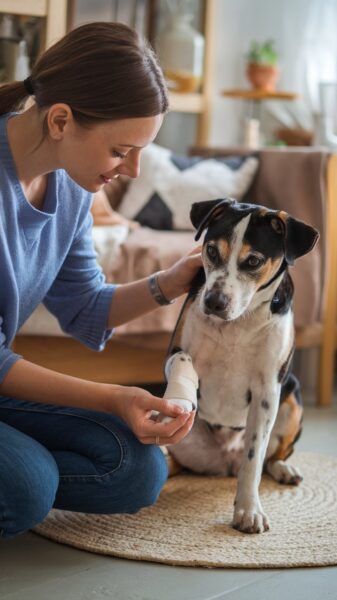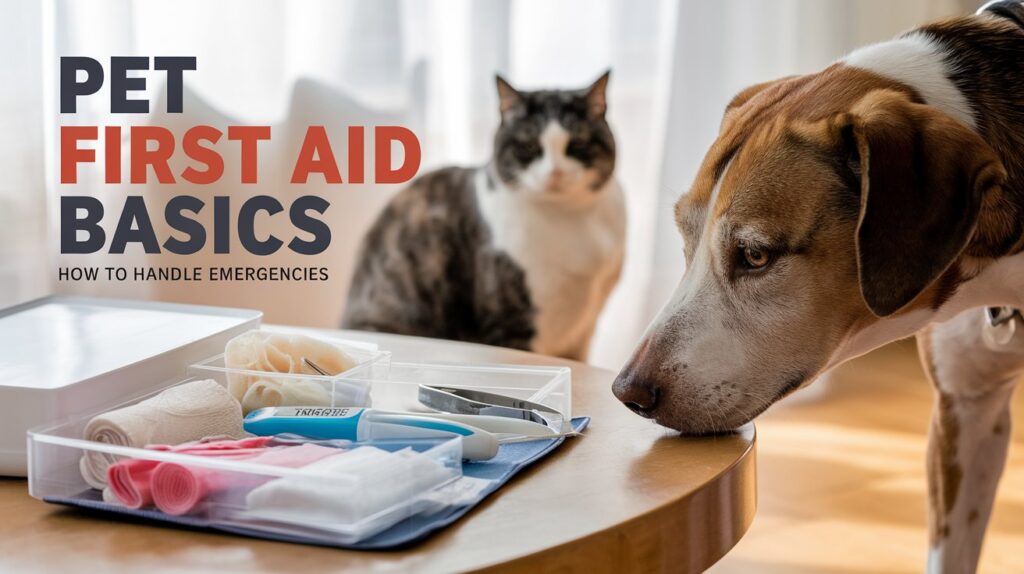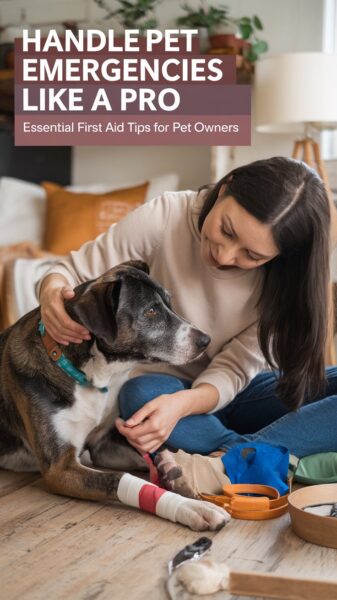When emergencies strike, knowing pet first aid basics so you can act swiftly can mean the difference between life and death for your beloved pet. From minor cuts to serious accidents, being prepared with basic pet first aid skills is essential. Let’s explore how to equip yourself with the knowledge and tools to handle emergencies confidently.
The Basics of Pet First Aid
What You Need in a Pet First Aid Kit
Having a well-stocked pet first aid kit can make all the difference in an emergency. A properly assembled kit ensures you’re ready to handle a range of scenarios, from minor injuries to more serious incidents. Here’s what you should include:
- Sterile gauze and bandages: For dressing wounds and stopping bleeding.
- Antiseptic wipes: To clean wounds and prevent infection.
- Tweezers and scissors: Useful for removing debris and cutting bandages.
- A digital thermometer: To check for fever or abnormal body temperature.
- Disposable gloves: To maintain hygiene while handling injuries.
- Pet-safe saline solution: For rinsing wounds or cleaning eyes.
- Styptic powder: Essential for stopping minor bleeding, such as from nails.
- Activated charcoal: Use only under veterinary guidance to counteract certain toxins.
- Emergency contact numbers: Keep your vet and poison control hotline information readily available.
For convenience, you can purchase pre-assembled pet first aid kits online. Check out this highly rated option on Amazon.
Pet First Aid Basics Every Owner Should Know
Being equipped with the right tools is just the first step. Knowing how to use them can save precious time during an emergency.
- CPR for Pets: In case your pet stops breathing, knowing how to perform CPR is vital. Here are the steps:
- Lay your pet on their side and clear their airway if necessary.
- Check for a pulse on the femoral artery or chest.
- If there’s no pulse, begin chest compressions (1 compression per second for small pets, 2 per second for large pets).
- Alternate with rescue breaths every 30 compressions by gently sealing their mouth and blowing into their nostrils.
- Checking Vital Signs:
- Temperature: Normal for dogs is 101-102.5°F; for cats, 100.5-102.5°F. Anything outside this range warrants veterinary attention.
- Heart Rate: Place your fingers on the inside of your pet’s thigh to feel for the pulse. Normal rates are 60-140 bpm for dogs and 140-220 bpm for cats.
- Respiration Rate: Count breaths for 15 seconds and multiply by four. Normal rates are 10-30 breaths per minute for dogs and 20-30 for cats.
Common Pet Emergencies and How to Handle Them
Wounds and Bleeding
- What to Do: Apply steady pressure with a clean cloth or gauze to stop bleeding. Once bleeding is controlled, clean the wound with pet-safe saline and cover it with a sterile bandage.

- When to See a Vet: Seek professional help if the bleeding doesn’t stop within 5 minutes, the wound is deep, or there’s excessive swelling.
Choking
- Signs: Watch for difficulty breathing, gagging, or pawing at the mouth.
- What to Do: Open your pet’s mouth and look for visible objects. Carefully remove the object with tweezers, being cautious not to push it further down. If the object is lodged, perform the Heimlich maneuver:
- For small pets: Place your hands around the rib cage and give firm yet gentle upward thrusts.
- For larger pets: Apply pressure below the ribcage while supporting their back.
Poisoning
- Common Toxins: These include chocolate, xylitol (found in sugar-free products), certain plants (like lilies), and medications.
- What to Do: Immediately call your vet or the ASPCA Poison Control Hotline (888-426-4435). Do not induce vomiting unless specifically directed to do so.
- Prevention Tip: Store harmful substances securely and consider pet-safe cleaning alternatives. Shop pet-safe options here.
Heatstroke
- Symptoms: Excessive panting, lethargy, drooling, vomiting, or collapse.
- What to Do: Move your pet to a shaded or cool area. Apply cool (not cold) towels to their body and offer small amounts of water. Contact your vet immediately, as heatstroke can quickly become life-threatening.
Broken Bones
- What to Do: Avoid moving the injured area as much as possible. Use a splint or a rolled towel to immobilize the limb. Transport your pet to the vet with care.
When to Go to the Vet
Some situations require immediate professional care. Be vigilant for these red flags:
- Persistent or uncontrollable bleeding.
- Difficulty breathing or signs of choking.
- Loss of consciousness or unresponsiveness.
- Repeated vomiting or diarrhea lasting more than 24 hours.
- Seizures or severe trauma.
Always have emergency contact numbers handy, including your primary vet and the nearest 24/7 clinic.
Preventative Tips to Avoid Emergencies
Create a Safe Environment
- Remove potential hazards from your home, such as toxic plants, loose cords, or small items that can be swallowed.
- Secure trash bins and keep cleaning products out of reach.
- Install proper fencing to keep outdoor areas safe.
Regular Preventative Care
- Keep up with routine veterinary checkups to address health issues early.
- Stay current with vaccinations and flea, tick, and parasite prevention treatments.
Training and Enrichment
- Teach commands like “leave it” to prevent your pet from picking up harmful items.
- Provide engaging toys and activities to reduce boredom-related accidents. Browse top-rated pet toys here.
Conclusion
Preparation and knowledge are your best defenses against pet emergencies. A well-stocked first aid kit and basic first aid skills can save your pet’s life. Remember, staying calm and acting quickly are key.
Ready to get started? Download our Pet First Aid Checklist today, and share this guide with fellow pet lovers to spread awareness. Together, we can ensure our furry friends stay safe and healthy!
Stay in the know and keep your pets happy and healthy! Sign up for our newsletter to receive expert pet care tips, exclusive content and helpful freebies straight to your inbox. Don’t miss out—join our community today!

























